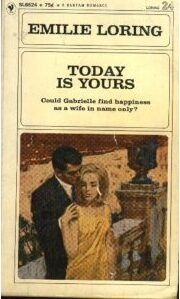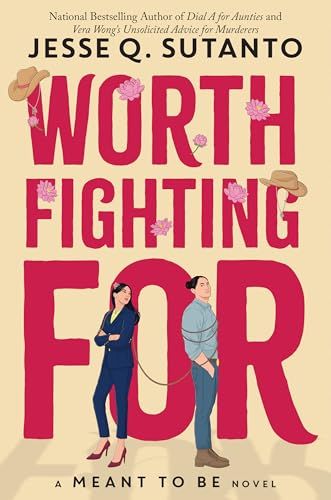A History of Book Affordability
For centuries, consumers have had access to affordable print reading materials. Penny dreadfuls emerged in the 1830s but came into prominence in the 1860s and 1870s in newsstands. These were disposable, salacious booklets that often included horror, fantasy, true crime, and other serial literature, like Sweeney Todd. As the name suggests, these weekly installments cost a penny (roughly $0.47 today). Other, more expensive serial literature like Charles Dickens cost a shilling (roughly $5.50 today). Although installments in serialized literature do not make up a whole book, it is important to track the history of low-cost options for English readers through the most popular format of the period.
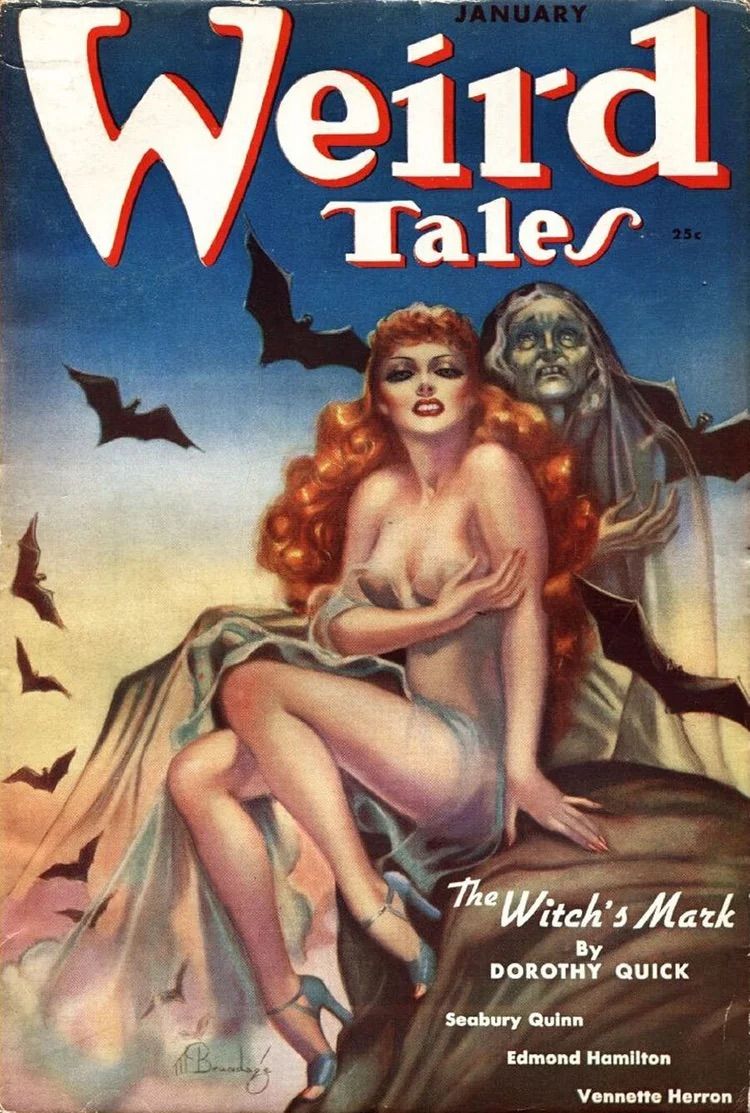
For these calculations, I used the Currency converter: 1270–2017, then the Bank of England Inflation Calculator, and then a Google search to convert pounds to dollars. Because I do not own these tools and mistakes can be made moving data across tools, I can say these are only approximate price estimates.
Book Radar
Sign up for Book Radar to receive exciting book deals and must-read forthcoming titles.
Moving forward, serialization remained a popular option for readers. In the late 19th to the mid-20th century, pulp magazines like Weird Tales (1923- roughly 1954) provided serialized short stories for $0.25 a copy (roughly $4.56 today). Alongside serialization, a new cheap book format, mass market paperbacks, emerged in 1938 from Penguin. In the 1900s-2000s, Harlequin, Avon, Topaz, Zebra, Bantam, and Mira Books, among others, began to publish pulp novels or mass market books for an affordable cost.
Although mysteries, thrillers, westerns, science fiction, and fantasy novels also have had large mass market print runs and subsequent pivots to trade paperback and hardcover books, my personal collection allows me to interrogate the romance market best. By looking at the affordability of romance books, I can study a subset of the affordable book market as it has changed over time.
The Mass Market Romance Price Index
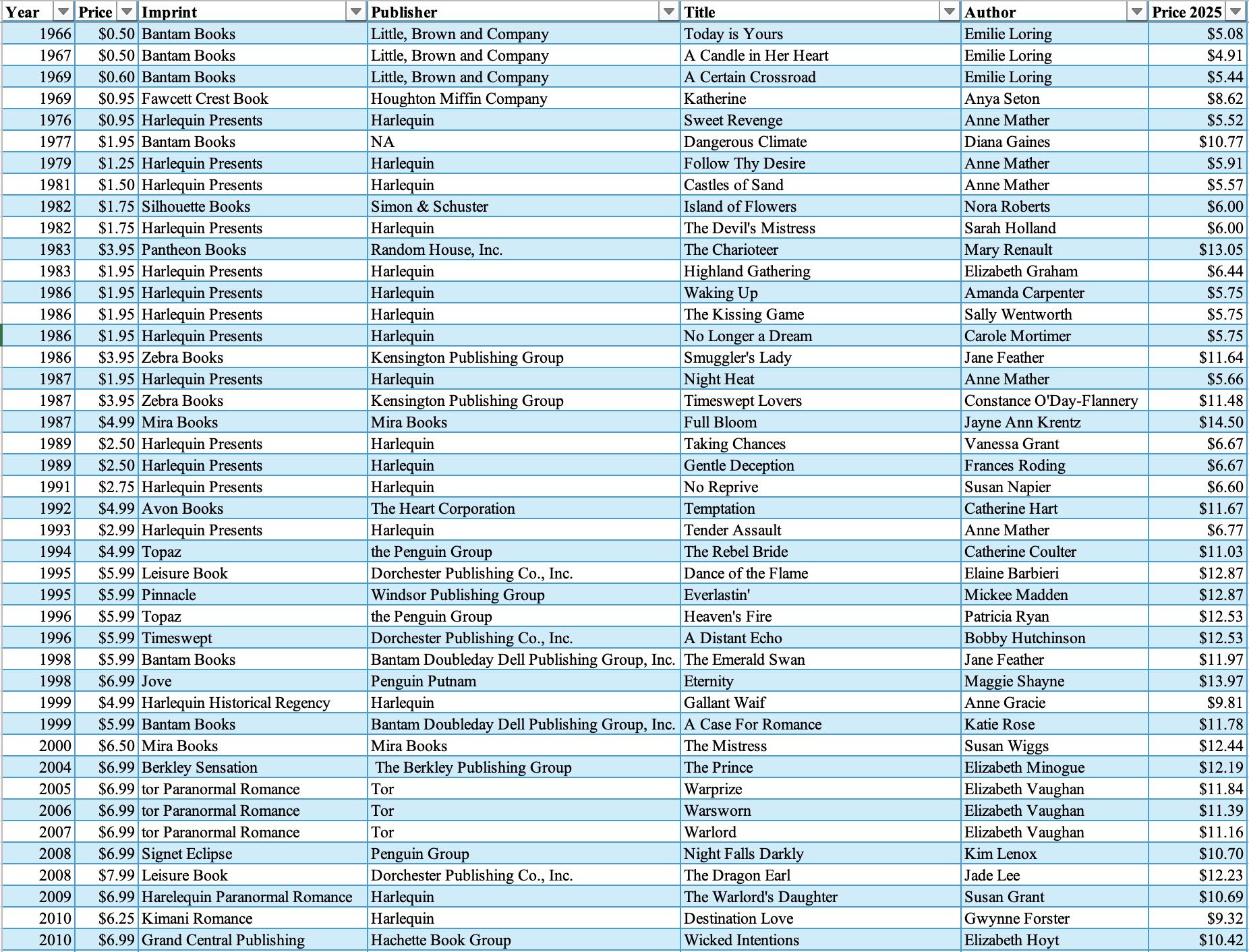

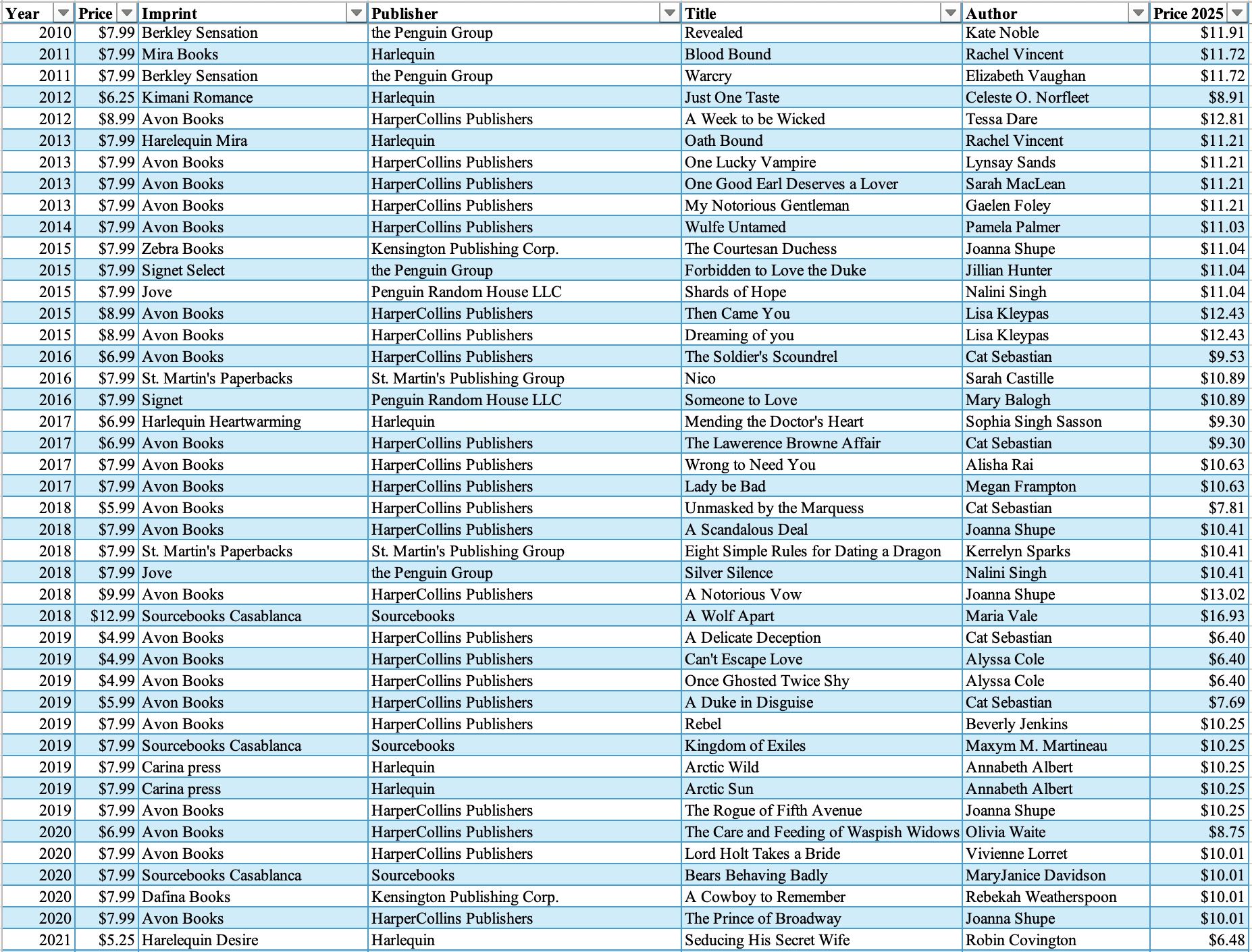

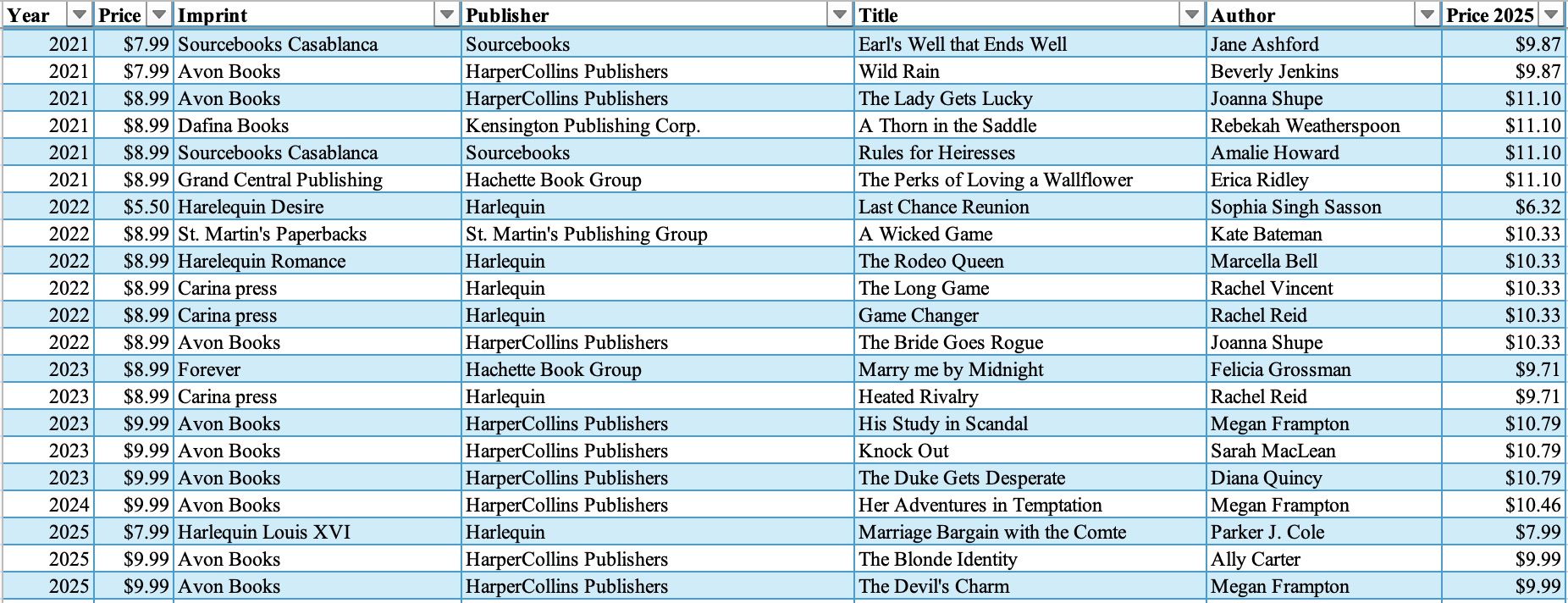

I indexed the prices of 107 romance mass market paperbacks in my collection printed between 1966 and 2025, noting the year, sticker price, imprint, publisher, title, author, and price adjusted for inflation in 2025. On average, they have cost about $10, accounting for inflation using the U.S. Bureau of Labor Statistics calculator.
The oldest mass market I have in my small archive is a 1966 copy of Today is Yours by Emilie Loring, printed by Bantam Books, an imprint of Little, Brown and Company, for $0.50 ($5.08 accounting for inflation). The newest mass market I have is a 2025 copy of The Devil’s Charm by Megan Frampton, printed by Avon Books, an imprint of HarperCollins Publishers, for $9.99. The detailed collection captures a range of imprints and titles, indicating that for decades, mass market paperback books have been a staple, low-cost option for readers at about $10 a piece. Or at least, that was the case.
Killing the Mass Market and Keeping the Trade Paperback
By the end of 2025, Readerlink, the largest distributor of mass market paperbacks, will stop distributing them altogether, noting the decline in mass market sales and the format’s thin margins. Although Kensington will continue to publish mass market cozy mysteries, it will not be publishing romance or thrillers. By and large, it appears publishers are planning to move to larger format (trade) paperbacks.
In comparison to mass markets, romance trade paperbacks in 2025 cost on average $18.57. The cheapest options in my collection cost $15.99 (Worth Fighting For by Jesse Q. Sutanto from Penguin Random House’s Disney Publishing Group imprint and The Secret Crush Book Club by Karmen Lee from Harlequin’s Afterglow Books imprint). The most expensive option in my collection costs $21.99 (Dire Bound by Sable Sorensen from Hachette’s Requited imprint).
In total, I indexed 19 trade paperback romances, accounting for almost every traditionally published romance imprint from Hachette, Amazon, HarperCollins, Macmillan, Penguin Random House, and Simon & Schuster. Across the board, trade paperback books are at least $5.99 more than a mass market alternative, leaving most genre readers without a low-cost book alternative.
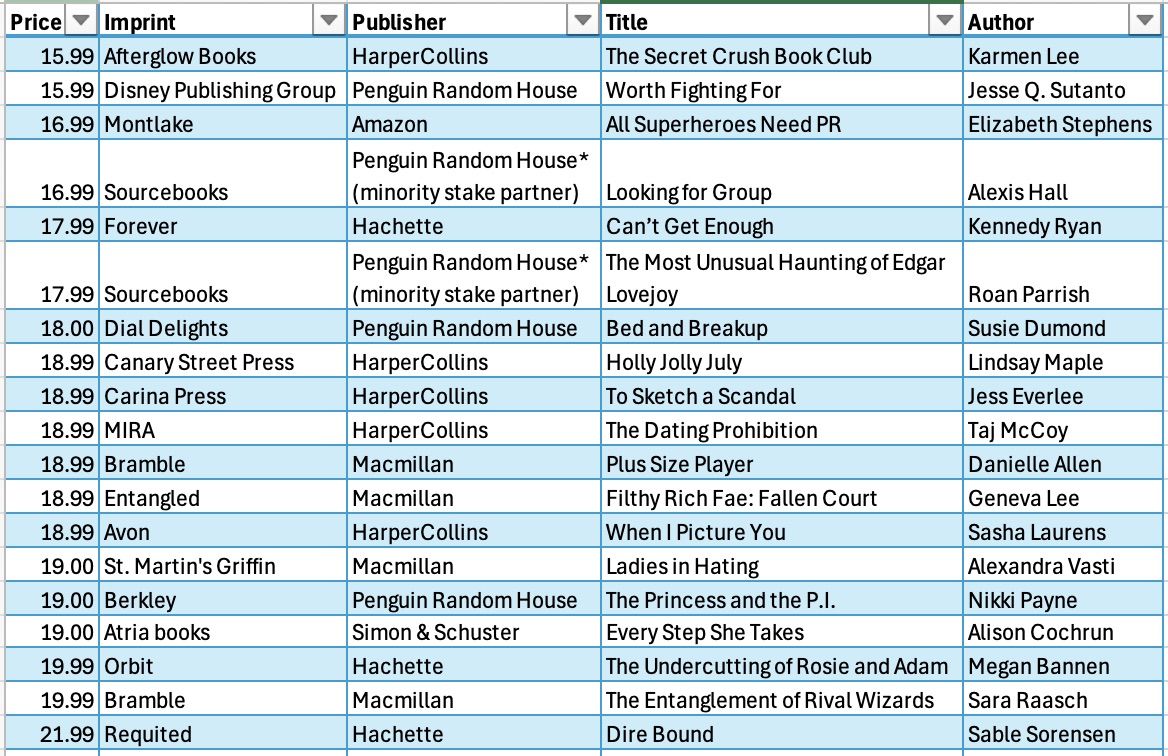

Why eBooks Aren’t an Affordable Solution
It is fair to point out that mass market paperbacks have not been big sellers for American book retailers. Indeed, many modern readers are picking up electronic copies of books, like audiobooks and ebooks, instead.
While audiobooks are expensive, ebooks are a relatively cheap alternative that can be downloaded immediately. However, consumers do not own these books in perpetuity. They are simply given limited access to the books through Digital Rights Management (DRM) licenses. Consumers cannot resell ebooks or share them with friends or archive them in any way. Because of these limitations to total ownership, I do not think digital copies of books replace the object value of paper books.
Why Kindle Unlimited Isn’t Solving the Book Affordability Crisis
Many readers have also turned to Kindle Unlimited subscription plans as a low-cost alternative, but I point to the high price point again. KU is currently $11.99 a month, $2 more than the average cost of a single mass market paperback book that readers own. Like any subscription, consumers do not own any of the content they are subscribed to.
As Amazon says in their terms of service, “From time to time, we may add or remove titles from the program and we make no guarantee as to the availability of specific titles or the minimum number of titles available.” Consumers can read many books a month for a potential low price point per book, but again, they have no claim to ownership of any material, nor are they guaranteed access to any single title.
Personally, if I want to read books I cannot own or resell, I check them out from my library—a public reading institution that was barred from stocking KU or Audible exclusive titles before 2025 per Amazon’s policies. That is all to say, I do not think KU is an acceptable, affordable option for consumers. A cheap book may not stand up to the wear and pressures of time; however, it can be owned, lent, and sold without restriction.
Outside of affordability, there is also an added issue of archivability under the KU model. Unless the author waits out the 90-day exclusivity clause and decides it is profitable for them to print copies of their book, these books live and die online. If KU decides to stop hosting the title for any reason, it is gone. There is no chance that 60 years later, someone can pick up a copy of that book and see how popular the genre operated in 2025.
What About Secondhand Books and Sales?
There are plenty of secondhand book-selling platforms and bookstores that have cheap books. There are also sales online and in-store that drop the sticker price of new books. I wrote a how-to guide that I still stand by. For me, these are not viable alternatives to the existence of a low-cost book format, readily available for consumers at face value.
Plus, secondhand or on-sale mass market paperbacks are still much cheaper than secondhand or on-sale trade paperbacks. It is important that there is an affordable book format on the market, including when it comes to the resale market.
The Mass Market was the Last Affordable Book Format, and We Lost It
What makes the removal of mass market paperbacks an indication of the book affordability crisis? Ultimately, I can accept mass market paperbacks as a thing of the past—at least in a majority of pulp genres, including romance. What I cannot accept is the existing cheap alternatives as a consolation prize. A trade paperback that is 50% more expensive—even accounting for inflation—and a pricy monthly book subscription are not enough to replace a $10 book you could own.
Mind you, this all comes at a time of wage stagnation and a cost-of-living crisis. Now is not the time to roll back affordable options for consumers in any entertainment space. It doesn’t help that on the back end, the editorial teams are not seeing dramatic increases in wages as a result of rolling back affordable book formats.
I understand that affordable literature has always been highly ephemeral. Many penny dreadfuls and Weird Tales magazines have been lost to time because they were considered cheap and disposable. Old mass markets from the 1900s are often thrown away, forgotten in basements, or sold for pennies at used bookstores desperate to get rid of admittedly low-demand stock. Even still, advocating for affordable physical media is important because it gives everyone the right to own, share, and sell the books they read. Publishers don’t have to make mass market books, but they should continue selling some book format for about $10.

